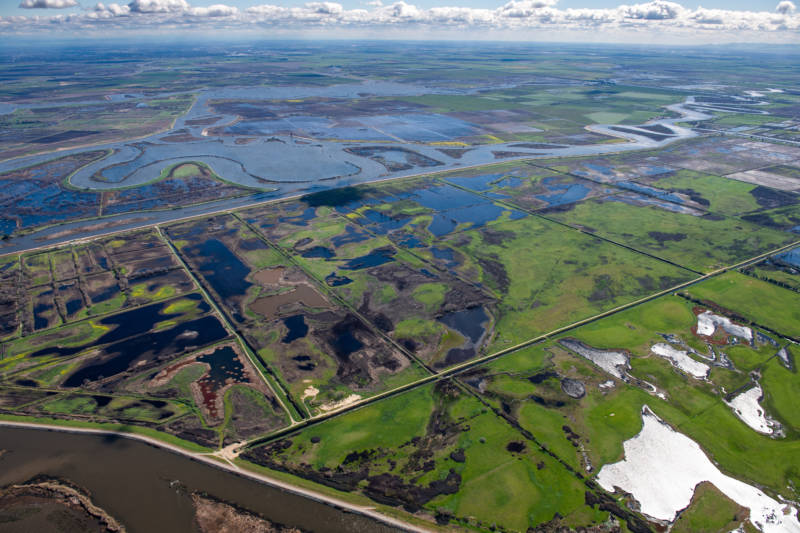Instead, the administration removed those biologists from the project and brought in other staff to rewrite their decision.
“We’ve been able to create a much smarter approach that focuses on real-time management,” said Paul Souza, U.S. Fish and Wildlife Service Pacific Southwest regional director. “Our commitment is that we will be as or more protective than we have been in the last 10 years.”
The water pumping rules are integral to the majority of California, since they govern a crucial water source: the Sacramento-San Joaquin Delta.
The water is also crucial to the survival of endangered salmon and threatened delta smelt, whose numbers have plummeted. Chinook salmon have lost as much as 90 percent of their historic river spawning grounds due to dam construction. As their numbers have gone down, so have endangered killer whales in the Pacific, which feed on the salmon while the fish are at sea.
The administration’s latest plan creates new hatcheries to breed fish and relies on real-time monitoring to track the location of threatened fish. Administration officials say they plan to slow pumping when fish are nearby.
Environmental and fishing groups say the decision is scientifically unsound and shows political interference. Prior to becoming Interior Department secretary, David Bernhardt was a lobbyist for Westlands Water District, a major agricultural district in the Central Valley.
“The servile Interior Department has hijacked and subverted the scientific process,” said Noah Oppenheim, executive director of the Pacific Coast Federation of Fishermen’s Associations in a statement. “Fishing jobs are being sacrificed to benefit the corporate agriculture lobby, pure and simple.”
What are these water rules?
The rules, known as “biological opinions,” generally have put environmental safeguards on the vast network of dams and pumping plants in California. At least two-thirds of Californians use water from this system, which goes through the delta. But it’s also meant dramatically altering the ecosystem.
Since salmon are born in rivers and migrate through the delta to reach the ocean, the rules have generally done two things. First, they slow speed of the massive pumps in the south delta, in order to protect fish from being drawn into the pumps. Second, they ensure salmon eggs in the Sacramento River aren’t killed by hot temperatures — that requires conserving water behind Shasta Dam so it can be released in the summer to keep the river cool.
Central Valley politicians and agricultural interests have long fought these rules, which reduce their water supply in some years.
When the Bureau of Reclamation, which delivers water to the Central Valley, proposed pumping more water from delta, it then fell to federal wildlife agencies to review that decision and write up what are called biological opinions. The agencies must put limits on the water pumping if they find the rules would harm endangered species. In this case, NOAA biologists did find that, but before their biological opinions were released in July, the Trump administration replaced the biologists with new staff to redo the analysis.
Fast-Tracking the Science
In October 2018, President Trump ordered that the water rules be written faster than ever before.
“We will have it done very, very quickly,” Trump said to members of the California GOP congressional delegation last October, as he signed an executive order. “I hope you enjoy the water that you’re going to have.”
According to emails obtained last winter by KQED, NOAA Fisheries scientists were concerned they didn’t have the resources to analyze the plan.
In July, those scientists found that the increased water pumping would “jeopardize” the existence of salmon and other species. Before that document was released, the Trump Administration brought in a new team of federal attorneys and decision makers to work on the rules, removing the biologists who had previously worked on it.
In the version released today, the Trump Administration found their plan would not jeopardize the existence of salmon or delta smelt.
What Are the Changes in the New Plan?
The Trump Administration says it will run its water-pumping operations based on real-time monitoring of fish populations, slowing pumping to avoid harming them when they’re near water infrastructure. Because of that, it can’t say how much water will reach farmers in the Central Valley.
“It’ll be some time before we operate in this new plan and be in a position to actually determine definitively whether and to what extent the new plan actually increases water supply,” said Ernest Conant, regional director for the Bureau of Reclamation. “It could very well in certain years decrease it.”
Environmental groups say monitoring the fish provides an inadequate look at where they are, because it’s difficult to track them when there are so few left.
“The new biological opinions eliminate the existing guardrails that limit real-time pumping, and simultaneously increase the number of salmon and other endangered species that can be killed,” said Doug Obegi of the Natural Resources Defense Council.
The administration says it will also share the cost for $1.5 billion in restoration and habitat projects. It plans to support a hatchery to breed delta smelt, a species on the brink of extinction and restore creeks vital to salmon.
What’s next?
The new rules could go into effect early next year, affecting the water deliveries for cities and farms during the spring and summer. But fishing and environmental groups are likely to sue, charging the rules don’t go far enough to avoid extinction of endangered species. Depending on what a judge decides, the rules could be tied up in court for years.

